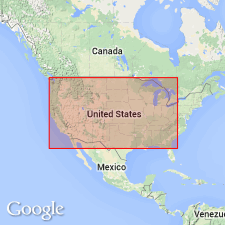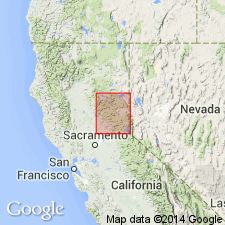
- Usage in publication:
-
- Robinson beds
- Modifications:
-
- First used
- Dominant lithology:
-
- Tuff
- Sandstone
- Conglomerate
- Slate
- AAPG geologic province:
-
- Sierra Nevada province
Summary:
Geologic column of Taylorville [Taylorsville] region shows Robinson beds to be 1150 ft thick and of Carboniferous age. Contains slates, conglomerate, tuff and sandstone "of which the last two are the most important". List of fossils identified by C.D. Walcott were found by Cooper Curtice in Genesee Valley. Younger than Shoo Fly beds and older than Hosselkus limestone and Swearinger slates.
Source: GNU records (USGS DDS-6; Menlo GNULEX).

- Usage in publication:
-
- Robinson formation*
- Modifications:
-
- Named
- Dominant lithology:
-
- Sandstone
- Shale
- Conglomerate
- Limestone
- Volcaniclastics
- AAPG geologic province:
-
- Sierra Nevada province
Summary:
Named for exposures on Robinson ranch (where it makes up mound east of the house) near Taylorsville, Plumas Co, CA. Is a succession of variable sedimentary rocks ranging from shale to conglomerate and composed chiefly of igneous material with occasional lentils of limestone. Most characteristic part is gray sandstone that weathers reddish brown. Contains more or less disseminated carbonate of lime forming small lentils up to 15 ft in thickness. Below the calcareous horizon reddish-brown thin-bedded tuffaceous sandstone and shale extend to bottom of Formation. Above the calcareous horizon pyroclastic material becomes somewhat coarser and passes into a tuffaceous conglomerate containing fossiliferous limestone nodules and beds of reddish-brown sandstone with here and there crinoid stems like that of principal horizon below. Is separated from older Peale formation (new) by Reeve meta-andesite (new). Is unconformably overlain by Hosselkus limestone. Age is Carboniferous based on fossils. Lists of fossils included in report.
Source: GNU records (USGS DDS-6; Menlo GNULEX).

- Usage in publication:
-
- Robinson Formation*
- Modifications:
-
- Age modified
- AAPG geologic province:
-
- Sierra Nevada province
Summary:
Robinson Formation is assigned to interval "C-D" (Ochoan and Guadalupian) of Permian age. Robinson Formation has been correlated with Nosoni Formation (Girty, in Diller, 1908, p.27) which is now thought to be of early Guadalupian age.
Source: GNU records (USGS DDS-6; Menlo GNULEX).

- Usage in publication:
-
- Robinson Formation*
- Modifications:
-
- Overview
- AAPG geologic province:
-
- Sierra Nevada province
Summary:
Author concurs with McMath's (1958, Ph.D. thesis) definition of Robinson Formation and McMath's designation of type section on northwest bank of Hosselkus Creek, sec.33 T26N R11E, Genesee Valley 7.5' quad [Plumas Co, CA]. At type section unit is about 200 m thick. Of five fossil localities included within Robinson as mapped by Diller (1908) only one is included in McMath's (1958, 1966) Robinson Formation; remaining four localities occur in McMath's Reeve Formation. Conodonts from Robinson Formation are indicative of mid-Permian (Wordian to Capitanian) age (K. Denkler and A. Harris, 1986, written commun.). Therefore age of Robinson is considered to be Early and Late Permian (Wordian to Capitanian).
Source: GNU records (USGS DDS-6; Menlo GNULEX).
For more information, please contact Nancy Stamm, Geologic Names Committee Secretary.
Asterisk (*) indicates published by U.S. Geological Survey authors.
"No current usage" (†) implies that a name has been abandoned or has fallen into disuse. Former usage and, if known, replacement name given in parentheses ( ).
Slash (/) indicates name conflicts with nomenclatural guidelines (CSN, 1933; ACSN, 1961, 1970; NACSN, 1983, 2005, 2021). May be explained within brackets ([ ]).

